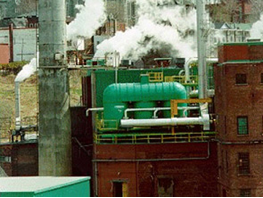
Kraft pulp mill
The use of sodium sulfide in the kraft pulping process causes the release of fumes whose unpleasant characteristic odour is well known. It is also recognized that in the digester, the sulfide ion combines with various chemical compounds derived from the wood to form organic sulfides such as methyl mercaptan (CH3SH), dimethyl sulfide (CH32S), dimethyl bisulfide (CH32S2) and hydrogen sulfide (H2S), as well as turpentine and methanol vapors. Together, these gases are called non-condensable gases (NCG). New environmental standards for the control of NCG emissions require kraft pulp mills to ensure a large reduction in these emissions, in Quebec, as in Ontario and in the United States (20 ppm and less). Until recently, NCGs were destroyed in the following manner:
- Low volume high concentration (LVHC) gases were incinerated in a lime kiln;
- High volume low concentration (HVLC) gases were incinerated in a black liquor boiler.
This approach resulted in substantial fuel consumption savings and partial absorption of the SO2. However, the disadvantages of this solution were numerous:
- Interference by the NCGs in the optimal operation of the lime kiln and the black liquor recovery boiler with the resultant exceeding of increasingly strict norms for releasing TRSs into the atmosphere;
- Operational problems with the lime kiln and boiler, such as fused salt accumulations, various organic and ash deposits.
The main advantage of a dedicated incinerator lies in the absence of interference with plant operations and the achievement of a high level of TRS destruction. Used for this application since 1996, the BIOTOX® process can be considered the Best Available Control Technology (BACT) at this time for meeting the industry’s strict standards for atmospheric releases. The application of BIOTOX® technology in the treatment of pulp and paper industry emissions is very recent. Biothermica has taken on several challenges in applying BIOTOX® regenerative thermal oxidation technology in the treatment of TRSs, such as:
- Adapting non-condensable gases to the production cycle;
- Simultaneous treatment of LVHC (low volume high concentration) gases and HVLC (high volume low concentration) gases;
- Controlling the mixture’s oxygen rate in a manner that keeps the mixture of gases below the lower explosive limit (LEL). (especially where LVHC gases are involved);
- Long-term durability of the device where corrosive gases are in contact with cold parts (entry pipes, inside shell of the combustion chamber, bed bottoms, packing supports, inside parts of dampers) etc…
Biothermica has succeeded in adapting BIOTOX® technology to pulp and paper emissions. The following improvements have been made:
- Development of methods that ensure the non-corrosiveness of incinerator equipment parts in contact with corrosive gases;
- Development of a regenerative incinerator preventive maintenance program.
In 1997, Biothermica established a Canadian premiere with the installation of a BIOTOX® unit at a kraft pulp mill. The unit reduced TRSs by 99.6% with a thermal recuperation rate of 88.5%.

